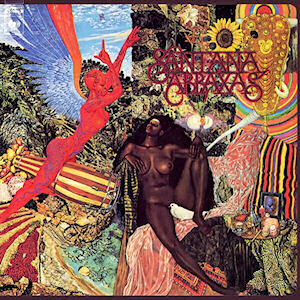
Abraxas (album)
Abraxas is the second studio album by Latin rock band Santana. It was released on September 23, 1970, by Columbia Records and became the band's first album to reach number one in the United States.[1]
This article is about the 1970 album by Santana. For the 2013 album by Shanir Ezra Blumenkranz, see Abraxas: Book of Angels Volume 19.Abraxas
September 23, 1970
April 17 – May 2, 1970
37:36
English, Spanish
Title[edit]
The title of the album originates from a line in Hermann Hesse's 1919 book Demian, quoted on the album's back cover: "We stood before it and began to freeze inside from the exertion. We questioned the painting, berated it, made love to it, prayed to it: We called it mother, called it whore and slut, called it our beloved, called it Abraxas..."[2]
Songs[edit]
Carlos Santana had been interested in Fleetwood Mac's leader and songwriter Peter Green, having seen him perform at the Fillmore West in San Francisco, and decided to cover the band's song "Black Magic Woman". Both were influenced as guitarists by B.B. King. The band added a cover of Gábor Szabó's instrumental "Gypsy Queen" to the end.[3]: 34–35 "Oye Como Va" was a hit by Tito Puente in the early 1960s and the group played it live regularly, as they realized it was good for audiences to dance to.[3]: 35
"Incident at Neshabur" was co-written by Santana and his friend Alberto Gianquinto, who played piano on the track. Gregg Rolie played the other keyboards, contrasting with Gianquinto's jazz-influenced style. It ran through various time and key signatures.[3]: 36
The instrumental, "Samba Pa Ti" ("Samba for You"), was written by Santana after he saw a jazz saxophonist performing in the street outside his apartment.[2]: par. 5 [3]: 36 It was later covered by José Feliciano, who added lyrics, and also by Angélique Kidjo, who put lyrics in Yoruba, on her album Oyo. It is also one of the tracks featured in Nick Hornby's book 31 Songs.[4]
The first three songs on side one segue into each other, creating a 14-minute, 28-second mini-suite.
Cover art[edit]
The album cover features the 1961 painting Annunciation by German-French painter Mati Klarwein.[5] According to the artist, it was one of the first paintings he did after relocating to New York City. Carlos Santana reportedly noticed it in a magazine and asked that it be on the cover of the band's upcoming album.[6] On the back of the record sleeve the cover art is just credited to 'MATI'. It is now considered a classic of rock album covers.[5][7][8] Klarwein went on to design album artwork for many notable artists, including Miles Davis, Herbie Hancock, Earth, Wind & Fire, and Gregg Allman.
Legacy[edit]
Abraxas was deemed "culturally, historically, or artistically significant" by the Library of Congress and was selected for preservation in their National Recording Registry in 2015.[20]